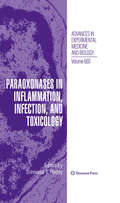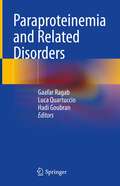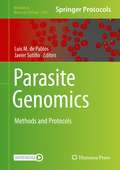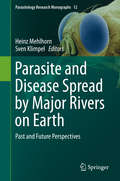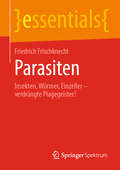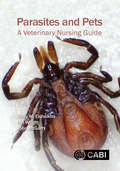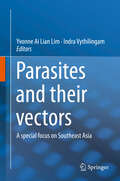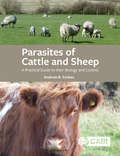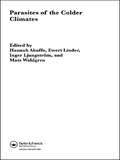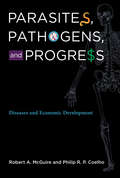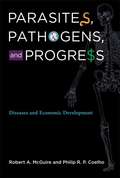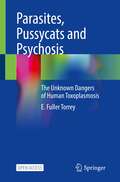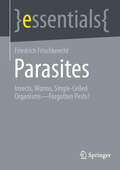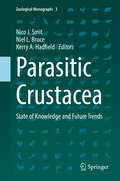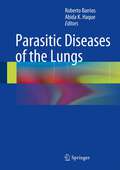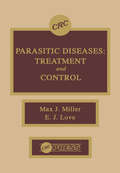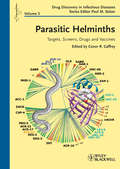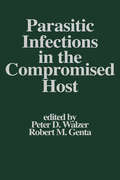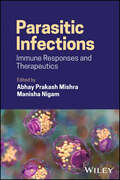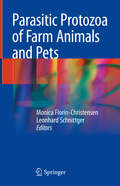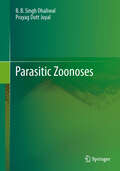- Table View
- List View
Paraoxonases in Inflammation, Infection, and Toxicology
by Srinivasa T. ReddyThe pivotal role of the Paraoxonases (PON) family in a variety of inflammatory diseases, e.g. atherosclerosis, in preventing the toxicity of organophosphorus insecticides and nerve agents and a variety of other compounds has made them an interesting target for both clinicians and scientists alike. Research into the paraoxonase (PON) family of enzymes (PON1, PON2 and PON3) has increased exponentially over the last five years especially following the initiation of paraoxonase conferences. The objectives of the 3rd ICP remains the same as the previous two conferences: to disseminate the latest aspects of research into the genetics, biochemistry, structural biology, regulation of PONs and their roles in inflammatory diseases e.g. atherosclerosis with expert lectures from 20 invited plenary lecturers and another 30-40 short and poster presentations from young investigators. The conference organizers anticipate a global attendance at the conference of between 150- 200 persons. Particular aspects of this conference will include the Bert N La Du Memorial Lecture, 3 Memorial Traveling Fellowships for Young Investigators and a round table discussion on the impact of the latest research on PON. UCLA provides a great venue for students, postdoctoral fellows and clinical scientists to interact with experts in the PON fields of study. The explosion of research into the PON family makes this a timely conference to review recent exciting advances in the field and provide an environment for cross-fertilization of ideas, particularly important for researchers new to the field.
Paraproteinemia and Related Disorders
by Gaafar Ragab Hadi Goubran Luca QuartuccioThis book presents paraproteinemia and the highly complex scientific information behind it to clinicians in a way they can understand and, ultimately, apply to their diagnostic and treatment practices. Paraproteinemia or dysproteinemia is characterized by the overproduction of an immunoglobulin by clonal expansion of cells from the B cells lineage which includes the plasma cells. The resultant monoclonal protein can be composed of the entire immunoglobulin or of its components. The identification and categorization of the different representatives of this group of disorders have traveled a long distance, but despite its high prevalence there is surprisingly limited evidence, in some areas, to guide the best clinical practice both at the time of diagnosis and during follow up. This book seeks to fill that gap. The book is divided into three sections, introductory chapters, disease entities and experimental therapies. The text guides clinicians through these diseases and disorders. The group of renal diseases attributed to deposition of monoclonal immunoglobulins or their components are arranged as one disease category in order to simplify the understanding of these complicated diseases in plasma cell dysplasia. In emulation of this practical approach, at a larger scale, the volume editors and chapter authors attempt to encompass the whole spectrum of the paraproteinemias in this text. This will have the dual benefit of offering the audience a panoramic view of this group of disorders and simultaneously keeping them focused on its individual representatives. There have been many recent advances in diagnosis, risk stratifications, and management of many members of this group of diseases and they are explored in depth here. This is an ideal guide for rheumatologists, hematologists, nephrologists, immunologists, oncologists, and relevant trainees caring for patients with paraproteinemia and related disorders.
Parasite Diversity and Diversification
by Serge Morand Serge Morand Boris R. Krasnov D. Timothy J. Littlewood Boris R. KrasnovThe development of molecular tools has dramatically increased our knowledge of parasite diversity and the vectors that transmit them. From viruses and protists to arthropods and helminths, each branch of the Tree of Life offers an insight into significant, yet cryptic, biodiversity. Alongside this, the studies of host-parasite interactions and parasitism have influenced many scientific disciplines, such as biogeography and evolutionary ecology, by using comparative methods based on phylogenetic information to unravel shared evolutionary histories. Parasite Diversity and Diversification brings together two active fields of research, phylogenetics and evolutionary ecology, to reveal and explain the patterns of parasite diversity and the diversification of their hosts. This book will encourage students and researchers in the fields of ecology and evolution of parasitism, as well as animal and human health, to integrate phylogenetics into the investigation of parasitism in evolutionary ecology, health ecology, medicine and conservation.
Parasite Genomics: Methods and Protocols (Methods in Molecular Biology #2369)
by Luis M. de Pablos Javier SotilloThis detailed book provides a comprehensive series of innovative research techniques and methodologies applied to the parasite genomics research area, all applying different approaches to analyzing parasite genomes and furthering the study of genetic complexity and the mechanisms of regulation. Beginning with chapters on novel sequencing and the bioinformatics pipeline, the volume continues by exploring diagnostic approaches using genomic tools, host-parasite interactions, as well as the genomics of parasite-derived extracellular vesicles. Written for the highly successful Methods in Molecular Biology series, chapters include introductions to their respective topics, lists of the necessary materials and reagents, step-by-step, readily reproducible laboratory protocols, and tips on troubleshooting and avoiding known pitfalls. Authoritative and practical, Parasite Genomics: Methods and Protocols creates a detailed picture of genomic approaches for researchers seeking a better understanding of characterizing parasite nucleic acid content.
Parasite and Disease Spread by Major Rivers on Earth: Past and Future Perspectives (Parasitology Research Monographs #12)
by Sven Klimpel Heinz MehlhornThis book focuses on waterborne pathogens and significant diseases occurring along major rivers around the globe, including key examples like the Amazonas, Mekong River and Nile. Written by leading international experts, it offers unique insights into local riverine infection risks in times of global warming, and addressing these through advances in diagnosis, health management and the development of simple but effective control measures. It also sheds light on why former societies collapsed due to transmitted diseases during periods of climate change, droughts and floods, to help establish effective preventive measures for the future. The book appeals to a wide readership, from scientists in the field of parasitology, infectious diseases and epidemiology, to healthcare managers and general readers with an interest in pathogen spread along the largest rivers on earth. It particularly highlights past and current control mechanisms in times of global warming and assesses potential future health hazards.
Parasiten: Insekten, Würmer, Einzeller – verdrängte Plagegeister? (essentials)
by Friedrich FrischknechtFriedrich Frischknecht gibt einen interessanten Einblick in die Lebensweisen von Parasiten. Vom kleinen Erreger der Malaria zum Bandwurm, vom Durchfall zur Verhaltensänderung des Wirts stellt er die faszinierende Welt der Parasiten vor. Dabei verdeutlicht er, warum Parasitismus eine so erfolgreiche Lebensweise darstellt und wie wir es trotzdem schaffen könnten, die schlimmsten Parasiten auszurotten.Der Autor:Prof. Dr. Friedrich Frischknecht hat nach dem Studium der Biochemie an der Freien Universität Berlin am Europäischen Molekularbiologischen Laboratorium (EMBL) in Heidelberg über Pockenviren promoviert. Nach einem Forschungsaufenthalt am Institut Pasteur in Paris leitet er seit 2005 eine Forschungsgruppe am Universitätsklinikum in Heidelberg und beschäftigt sich mit den molekularen Grundlagen der Bewegung von Malariaparasiten.
Parasites and Pets: A Veterinary Nursing Guide
by John McGarry Hany Elsheikha Dr Ian WrightThis book, primarily focussing on parasitic diseases of cats and dogs, is designed specifically for veterinary nurses and students and adopts an enquiry based approach essential for consolidating knowledge and a deep practical understanding of this important subject. The book goes beyond the conventional discourse of parasitology books, with each chapter addressing questions commonly posed by clients. It is illustrated throughout with colour figures and readers can assess their knowledge and areas for development by completing the end of chapter self-assessment questions. In this way, the veterinary nurse will be fully equipped to professionally support veterinary surgeons in achieving optimal strategies for management of parasitic diseases of companion animals. Provides a unique enquiry-based approach to assist veterinary nurses and technicians in gaining essential knowledge and practical understanding of parasites Contains self-assessment MCQ sections designed to encourage the reader to question their practice, rationales, and the evidence base of parasitology care delivery they provide to patients Focuses on the dog and cat, the most commonly seen pets
Parasites and Pets: A Veterinary Nursing Guide
by Ian Wright John McGarry Hany M. ElsheikhaThis book is designed specifically for veterinary nurses and veterinary nursing students, and adopts an inquiry-based approach to assist veterinary nurses in gaining the essential knowledge and practical understanding necessary to excel in supporting veterinary surgeons to achieve an optimal management of parasitic diseases of dogs and cats. Supported by figures and ending with learning outcomes, each chapter includes a number of questions and answers about a major group of parasites. Readers can also identify their own abilities and areas for development by completing the end-of-chapter self-assessment questions, answers to which can be found at the back of the book. The questions are designed to encourage veterinary nurses to question their practice, rationales, and the evidence base of parasitology care delivery they provide to the patients. By completing all chapters and associated exercises within this book, the readers will gain the essential parasitology knowledge and professional skills needed for parasitology practice.
Parasites and their vectors
by Yvonne Ai Lian Lim Indra VythilingamSoutheast Asia is a region where a myriad of infections are endemic. It is a hotspot region for parasitic diseases. Currently, information on parasitic infections and vectors found in Southeast Asia is sporadic and there has been no attempt to extensively collate and integrate these data. Gaps in our knowledge, which include disease patterns, transmission dynamics and vectors still exist. This book highlights parasitic diseases that are peculiar to Southeast Asia, pinpoints similarities and differences between disease patterns in the respective member countries and provide information on new emerging parasitic diseases in this region. Critically, this book will heighten understanding of parasitic diseases and their vectors in this diverse region and this knowledge will be significant for future regional research efforts in this field.
Parasites in Ecological Communities
by Melanie J. Hatcher Alison M. DunnInteractions between competitors, predators and their prey have traditionally been viewed as the foundation of community structure. Parasites - long ignored in community ecology - are now recognized as playing an important part in influencing species interactions and consequently affecting ecosystem function. Parasitism can interact with other ecological drivers, resulting in both detrimental and beneficial effects on biodiversity and ecosystem health. Species interactions involving parasites are also key to understanding many biological invasions and emerging infectious diseases. This book bridges the gap between community ecology and epidemiology to create a wide-ranging examination of how parasites and pathogens affect all aspects of ecological communities, enabling the new generation of ecologists to include parasites as a key consideration in their studies. This comprehensive guide to a newly emerging field is of relevance to academics, practitioners and graduates in biodiversity, conservation and population management, and animal and human health.
Parasites of Cattle and Sheep: A Practical Guide to their Biology and Control
by Andrew B ForbesUnderstanding parasite biology and impact is essential when giving advice on parasite control in farm animals. In the first review devoted to parasites of domestic cattle and sheep alone, this book provides in-depth, focused advice which can be tailored to individual farms. It considers the impact of parasites, both as individual species and as co-infections, as well as epidemiological information, monitoring, and diagnostic procedures. Supported throughout by diagrams and photos to aid diagnosis, it also reviews the basis for control measures such as the responsible use of parasiticides, adaptive animal husbandry and other management practices. This book: Focuses on common parasites of domestic sheep and cattle; Places emphasis on understanding host responses and epidemiology so that the impact and seasonality of parasitism can be incorporated into advice and decision making; Highlights the fundamental importance of the individual farm and farmer in assessing endemic parasitism and tailoring control options accordingly; Provides a comprehensive reference listing, including important historical citations, to underpin the content. An important resource for students, veterinarians and researchers of farm animal health, this book maintains a focus on ruminant parasitology in order to deliver evidence-based advice and also context for the application of basic research.
Parasites of Marine Fish and Cephalopods: A Practical Guide
by Sven Klimpel Thomas Kuhn Julian Münster Dorian D. Dörge Regina Klapper Judith KochmannThis textbook provides a comprehensive, reliable and practical guide to the dissection and parasitological examination of marine fish and cephalopods. The first part provides a general introduction, presenting basic information on: parasitology, ecology of the marine environment, history and methods of fisheries and aquaculture, as well as the ecology of marine fish and cephalopods and the impact of parasites on hosts. In turn, the second part provides general information on the morphology and anatomy of marine fish and cephalopods using the example of abundant morphotypes (including e.g. habitus photos of the body cavity and internal organs). The third part covers the relevant parasitic groups, their ecology (e.g. lifecycles, transmission), related diseases, and detection. The fourth part, a comprehensive methods section, provides essential protocols and applications of common dissection methods (for roundfish, flatfish and cephalopods) and stomach content analyses, as well as parasite preservation, preparation and molecular identification. Basic calculations of the most common infection and ecological parameters are also introduced. The book’s fifth and final part provides information on health risks associated with fish and cephalopod consumption, as well as the prevention of human infection through the correct handling and processing of fish samples. The appendix provides e.g. blank sheets for recording fish dissections and parasitological examinations.
Parasites of the Colder Climates
by Hannah Akuffo Ewert Linder Inger Ljungström Mats WahlgrenThe parasitic load in cold northern climates is widely under-appreciated. Many texts on parasitology concentrate on tropical parasitic infections, so the reader can be forgiven for thinking that parasites are not a problem in the northern part of the world. Parasites of the Colder Climates redresses the balance by focusing on parasites indigenous t
Parasites, Pathogens, and Progress: Diseases and Economic Development
by Robert A. McGuire Philip R. CoelhoThe crucial role played by diseases in economic progress, the growth of civilizations, and American history.In Parasites, Pathogens, and Progress, Robert McGuire and Philip Coelho integrate biological and economic perspectives into an explanation of the historical development of humanity and the economy, paying particular attention to the American experience, its history and development. In their path-breaking examination of the impact of population growth and parasitic diseases, they contend that interpretations of history that minimize or ignore the physical environment are incomplete or wrong.The authors emphasize the paradoxical impact of population growth and density on progress. An increased population leads to increased market size, specialization, productivity, and living standards. Simultaneously, increased population density can provide an ecological niche for pathogens and parasites that prey upon humanity, increasing morbidity and mortality. The tension between diseases and progress continues, with progress dominant since the late 1800s.Integral to their story are the differential effects of diseases on different ethnic (racial) groups. McGuire and Coelho show that the Europeanization of the Americas, for example, was caused by Old World diseases unwittingly brought to the New World, not by superior technology and weaponry. The decimation of Native Americans by pathogens vastly exceeded that caused by war and human predation.The authors combine biological and economic analyses to explain the concentration of African slaves in the American South. African labor was more profitable in the South because Africans' evolutionary heritage enabled them to resist the diseases that became established there; conversely, Africans' ancestral heritage made them susceptible to northern “cold-weather” diseases. European disease resistance and susceptibilities were the opposite regionally. Differential regional disease ecologies thus led to a heritage of racial slavery and racism.
Parasites, Pathogens, and Progress: Diseases and Economic Development
by Robert A. Mcguire Philip R. P. CoelhoIn Parasites, Pathogens, and Progress, Robert McGuire and Philip Coelho integrate biological and economic perspectives into an explanation of the historical development of humanity and the economy, paying particular attention to the American experience, its history and development. In their path-breaking examination of the impact of population growth and parasitic diseases, they contend that interpretations of history that minimize or ignore the physical environment are incomplete or wrong. The authors emphasize the paradoxical impact of population growth and density on progress. An increased population leads to increased market size, specialization, productivity, and living standards. Simultaneously, it can provide an ecological niche for pathogens and parasites that prey upon humanity, increasing morbidity and mortality. The tension between diseases and progress continues, with progress dominant since the late 1800s. Integral to their story are the differential effects of diseases on different ethnic (racial) groups. McGuire and Coelho show that the Europeanization of the Americas, for example, was caused by Old World diseases unwittingly brought to the New World, not by superior technology and weaponry. The decimation of Native Americans by pathogens vastly exceeded that caused by war and human predation. The authors combine biological and economic analyses to explain the concentration of African slaves in the American South. African labor was more profitable in the South because Africans' evolutionary heritage enabled them to resist the diseases that became established there; conversely, Africans' ancestral heritage made them susceptible to northern "cold-weather" diseases. European disease resistance and susceptibilities were the opposite regionally. Differential regional disease ecologies thus led to a heritage of racial slavery and racism.
Parasites, Pussycats and Psychosis: The Unknown Dangers of Human Toxoplasmosis
by E. Fuller TorreyThis open access book analyzes the evidence linking Toxoplasma gondii to the increasing incidence of schizophrenia and bipolar disorder in the United States. Initially establishing that infectious agents are regularly transmitted from animals to humans, lead to human disease, and that infectious agents can cause psychosis, it then examines the protozoan parasite Toxoplasma gondii in detail. Infecting 40 million Americans, Toxoplasma gondii is known to cause congenital infections, eye disease, and encephalitis for individuals who are immunosuppressed. It has also been shown to change the behavior of nonhuman mammals, as well as to alter some personality traits in humans. After discussing the clinical evidence linking Toxoplasma gondii to human psychosis, the book elucidates the epidemiological evidence further supporting this linkage; including the proportional increase in incidence of human psychosis as cats transitioned to domestication over 800 years. Finally, the book assesses the magnitude of the problem and suggests solutions.Parasites, Pussycats and Psychosis: The Unknown Dangers of Human Toxoplasmosis provides a comprehensive review of the evidence linking human psychosis in the United States to infections of Toxoplasma gondii. It will be of interest to infectious disease specialists, general practitioners, scientists, historians, and cat-lovers.
Parasites: Insects, Worms, Single-Celled Organisms – Forgotten Pests? (essentials)
by Friedrich FrischknechtFriedrich Frischknecht provides an interesting insight into the lifestyles of parasites. From the tiny agent of malaria to the tapeworm, from diarrhea to changes in the host's behavior, he presents the fascinating world of parasites. In doing so, he clarifies why parasitism represents such a successful way of life and how we might still manage to eradicate the worst parasites.
Parasitic Crustacea: State of Knowledge and Future Trends (Zoological Monographs #3)
by Nico J. Smit Niel L. Bruce Kerry A. HadfieldThis book offers the first comprehensive review of parasitic Crustacea, which are among the most successful and diverse parasites. Starting with an introductory chapter, followed by an historic overview and topic-specific chapters, each presenting a different aspect of parasitic crustacean biology, it enables readers to gain a better understanding of how these parasites function and allows direct comparisons between the different parasitic crustacean groups. The authors also discuss, in depth, the adaptations and interactions that have made parasitic Crustacea as successful as they are today, covering topics ranging from the history of their discovery, their biodiversity, phylogeny, evolution and life strategies to their role as vectors, or hosts of other organisms, and their significance in ecological processes. Consisting of ten chapters from leading international experts in the field, this volume offers a one-stop resource for all researchers, lecturers, students and practitioners.
Parasitic Diseases of the Lungs
by Roberto Barrios Abida K. HaqueDiagnosis of parasitic lung diseases is often difficult as their clinical manifestations can mimic common respiratory illnesses and routine tests can fail to detect the infections. Parasitic Diseases of the Lungs is designed as a practical guide for pathologists who encounter parasitic diseases of the lung in their daily routine. The book comprises eight chapters. After discussion of the handling of lung biopsies from patients with suspected parasitic disease, individual chapters focus on Protozoa, Nematoda, Trematoda, and Cestoda. The morphologic patterns associated with various parasitic infections are then analyzed, and differentiation between artifacts and parasites is discussed. The final chapter is devoted to the immunocompromised patient and covers general principles of histologic evaluation, parasites associated with HIV and AIDS, and the features of diffuse alveolar damage.
Parasitic Diseases: Treatment & Control
by Max J. Miller Edgar LoveBased on papers presented at the XI International Congress for Tropical Medicine and Malaria, this publication provides an authoritative evaluation of treatment and control of helminth parasite infections. A section on leprosy and a brief review of malaria vaccination are included. A comprehensive review of the history of schistosomiasis control programs presents information unavailable elsewhere. This book is of special interest to professionals concerned with health problems of less developed countries and in particular to public health officials, epidemiologists and clinicians dealing with patients in or returning from the tropics.
Parasitic Helminths: Targets, Screens, Drugs and Vaccines (Drug Discovery in Infectious Diseases)
by Paul M. SelzerThis third volume in the successful 'Drug Discovery in Infectious Diseases' series is the first to deal with drug discovery in helminthic infections in human and animals. The result is a broad overview of different drug target evaluation methods, including specific examples of successful drug development against helminthes, and with a whole section devoted to vaccine development. With its well-balanced mix of high-profile contributors from academia and industry, this handbook and reference will appeal to a wide audience, including parasitologists, pharmaceutical industry, epidemiologists, and veterinary scientists.
Parasitic Infections in the Compromised Host (Infectious Disease And Therapy Ser. #1)
by Peter D. Walzer Robert M. GentaThe first in a new series created to acknowledge the explosion of knowledge in fields related to infectious disesases and clinical microbiology. Thirteen contributions focus on organisms which are of major medical importance in this country or which have contributed to an understanding of pathology.
Parasitic Infections: Immune Responses and Therapeutics
by Abhay Prakash Mishra Manisha NigamParasitic Infections Understand and defeat a scourge of public health with this cutting-edge guide Parasitic diseases are considered as an important public health problem due to the high morbidity and mortality rates, particularly in countries where climate and level of economic development create serious challenges to the creation of public health infrastructure, thus can make parasitic infections both graver and more difficult to contain. As we come to understand the global ramifications of public health, there has never been a more crucial time to understand these infections and the processes by which they can be managed and defeated. Parasitic Infections is a comprehensive overview of parasitic immunopathology, including the fundamentals of parasite biology, mechanisms and processes of infection, and the key steps of drug discovery and treatment. In addition to detailed coverage of the most commonly encountered infectious parasites, analysis of the immune system provides material pertinent to any possible parasitic infection. The result is an essential contribution to public health research. Parasitic Infections readers will also find: A careful balance of parasite immunopathology and pharmaceutical analysis Detailed discussion of parasites such as protozoans, helminths, and ectoparasites Case studies and in-depth analyses written by authors around the world on the basis of first hand investigation Parasitic Infections is a must-read for researchers or professionals in immunology, biology, medicinal chemistry, drug development or pharmaceutical research, and all related fields.
Parasitic Protozoa of Farm Animals and Pets
by Monica Florin-Christensen Leonhard SchnittgerThis book provides an in-depth yet concise overview of the most common and emerging protozoa that cause diseases in both farm animals and companion animals. As outlined in the concise introduction, pathogenic protozoans represent an evolutionary highly diverse and little understood group of disease-causing microorganisms. For each of the featured parasitic unicellular eukaryotes, it discusses the morphology, lifecycle, epidemiology and host-pathogen interactions. In addition, the book highlights the latest developments in diagnostic methods, as well as prevention and treatment strategies. Thorough information on genomes and genetic manipulation strategies for some of the protozoa covered in this book is also included. Infections involving parasitic protozoa can cause productivity losses and/or reduce the quality of life of infected animals. Some infections are zoonotic, posing an on-going public health threat. In most cases, prevention and treatment are either non-existent or need considerable improvement. On the other hand, a great deal of research has recently been conducted on these organisms, yielding valuable new information on their global distribution and revealing the mechanisms of host-pathogen interactions at the molecular level – and essential insights that can be used for the development of new control tools. This book includes extensive information on both basic aspects and recent scientific discoveries on these protozoa and thus constitutes a unique resource for students, veterinarians, and researchers alike.
Parasitic Zoonoses
by Prayag Dutt Juyal B.B.Singh DhaliwalThe book "Parasitic Zoonoses" emphasizes a veterinary and public health perspective of zoonotic parasites. This book is suitable for higher undergraduate and graduate students of zoonoses and public health, veterinary parasitology, parasite epidemiology; public health workers; public health veterinarians; field veterinarians, medical professionals and all others interested in the subject. More than 15 protozoa and 50 other parasitic diseases are zoonotic in nature and all these diseases have been discussed in detail. The first chapter is concerned with classification of zoonotic parasites, food borne, vector borne and occupation related zoonotic parasites. The remaining chapters cover etiology, epidemiology, life cycle, transmission, clinical signs, diagnosis, prevention and control of zoonotic parasites. The text is illustrated with a large number of coloured figures. An alphabetical bibliography for every disease has also been included so that readers have access to further information.
